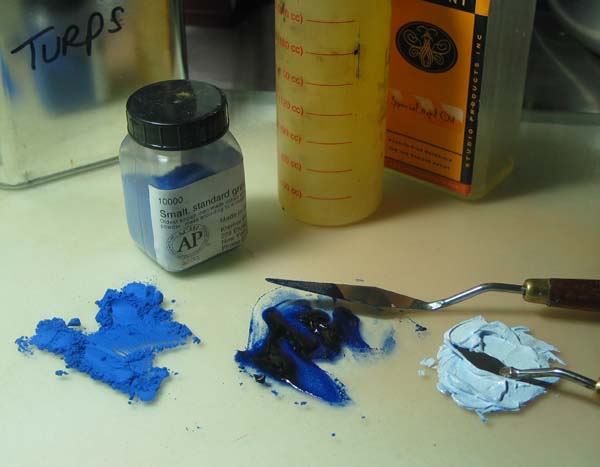Many of the history books I have read over the past months often give multiple names for one pigment. This is something that has happened over and over again for the historic pigment called SMALT. Ralph Mayer states in his book, The Artist’s Handbook of Materials and Techniques, it is a kind of cobalt blue glass.
As many as 3000 years ago, the Egyptians made this color with one critical difference. They used that pesky poisonous ingredient, copper. They called theirs, Egyptian Blue. In the 17th Century the Saxons figured out how to roast it using cobalt instead of the copper.
Other names for smalt are eschel, email, esmail, and King’s blue. There are many faults to this pigment, most specifically, courseness, impurities, and low tinting power. Here you can see it in powder form, mixed with linseed, and finally with white. I used quite a big gob of the blue and there was almost no noticeable change to the white. The low tinting or low saturation properties are very apparent here. It would take a lot of the smalt pigment to alter the white into a darker shade.

Many artists used smalt for its drying properties. Because it is low in tinting, a little was added to mixtures to speed drying, for instance, in a black which I have described as a very poor dryer. Unfortunately, smalt also darkened easily, although there is contradictory information here also.
In Donald Fels book, Lost Secrets of Flemish Painting, and quoted from the De Mayerne Manuscript, “smalt discolors easily and even if it appears beautiful and feels very fine when bought, no judgment can be made until it is mixed with oil and white lead, and allowed to dry; only then can it be seen whether it will become darker. The usual commercial smalt darkens and fades.”
Other writings state if smalt is mixed very lightly with white on the palette it will not darken. None other than Peter Paul Rubens described his method in the same Fels book, “to make smalt beautiful and bright it is necessary to mix it quickly with varnish, to apply it thinly and not laboriously, not to mix the paints in a wet condition too much, because this movement spoils the colors.”
It is easy to understand the dilemma artists faced concerning this type of pigment. This would be a very interesting experiment to undertake. Make color swatches of smalt and oil, smalt and lead white, and record the dates. Cover 1/2 of each swatch with a thick paper, place in a window, and just wait for a while.
For now, smalt will not be included in my list of pigments for my Lessons from the Low Countries Project. There are too many issues which would jeopardize the integrity and archival qualities of this series. I’ll stick with colors that have been proven by the test of time.

This is very interesting, I never heard of the pigment smalt before and certainly not that it also was known as King’s Blue. In it’s modern version King’s Blue is one of my favorite colors.
Dear Margret, The Smalt is a very old and very reliable pigment. Because of its very high price in the historic times there have been many reduced qualities on the market. Today and in the past the pigment Smalt is a very stable glass pigment, lightfast and stable in oil, distemper and watercolor. The old qualities were not very stable in lime, if exposed to steady wetness. Smalt got never mixed with Lead white, only with transparent glass powders or chalk. Best colorful regards Georg Kremer
Dear Dr. Kremer, I can’t thank you enough for your invaluable information about SMALT. Up until now, I have been very reluctant to use this color because of the vague and contradictory information in research books about pigments. It is of profound importance to me that my series paintings are executed with archival materials and techniques. Therefore, I have avoided using certain ones until I can learn more information. Because of your clear and concise analysis of smalt’s properties, it is clear it can be used safely. Because all eleven of my Lessons from the Low Countries paintings are now complete, perhaps, I will use smalt in my next project. With appreciation, Margret Short